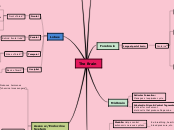by Emily Cummings 7 years ago
182
The Brain

by Emily Cummings 7 years ago
182

Axon ends at Terminal Buttons
Terminal Buttons discharge neurotransmitters into Synapse
Neurotransmitters pass across Synapse, merge with Receptor of adjacent Neuron
Certain neurotransmitters fit into certain Receptors, often called "lock and key" relationship
Synapse: Tiny space between two neurons
Contains synaptic vesicles that hold neurotransmitters
-Allows small molecules, and molecules with smaller charge. -Larger molecules and molecules with higher charge unable to permeate cell
Excretes sexual hormones important for sexual motivation, reproduction
Male: Testes
Female: Ovaries
Abdominal internal organ, secretes hormones to regulate body's blood sugar
Glucagon (raises blood sugar)
Insulin (lowers blood sugar)
Glands sit on top of kidneys, produce hormones associated w/ stress response
Norepinephrine (noradrenaline)
Epinephrine (adrenaline)
Located in neck: Responsible for growth, metabolism, appetite, etc
"Master Gland"; Controls all other glands in endocrine system
Body temp., growth hormones, regulates body fluid levels
Primary visual cortex: Processes visual info
Wernicke's Area: Speech understanding
Auditory Cortex: Processes auditory (hearing) info
Somatosensory Cortex: Processes sensory data
Touch, temperature, pain, etc
Broca's Area: Langauge
Motor cortex: Plans, coordinates movement
Prefrontal cortex: Manages high-level functioning
Limbic System
3 Most Imp. Parts
Hypothalamus: Regulates a number of homeostatic processes
Used as connection between endocrine system & nervous syst.
Ex: Body temp, appetite, blood pressure, etc.
Amygdala: Manages emotion and memory, and the relationship between the two
Hippocampus: Learning & memory
Pituitary Gland
Produces growth hormones, endorphins, and manages fluid levels
"Messenger hormones": Control all endocrine glands
Thalamus
All senses other than smell processed here
"Sensory relay"
Motor nerves: Send messages out
Sensory nerves: Take messages to brain